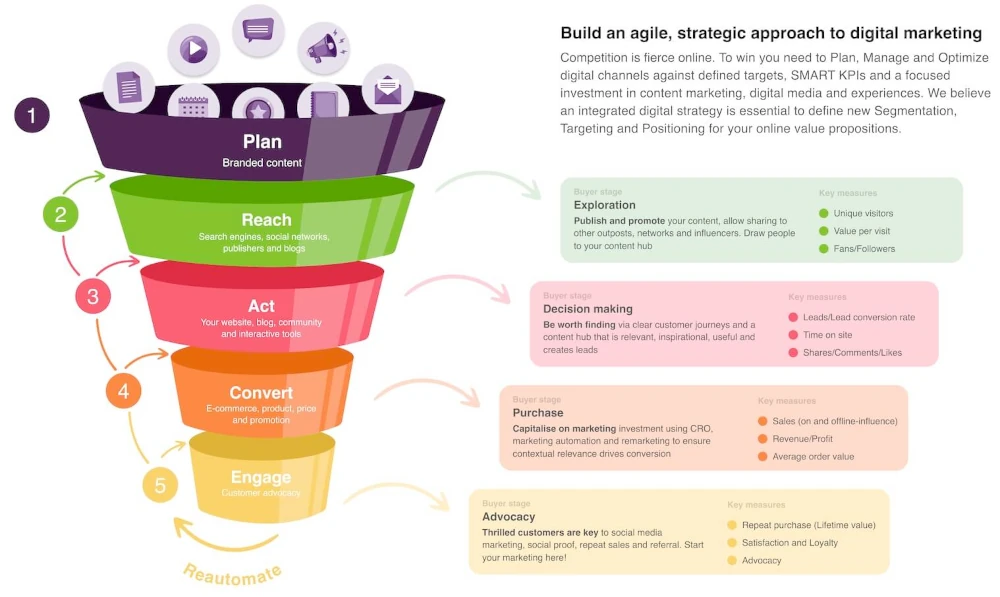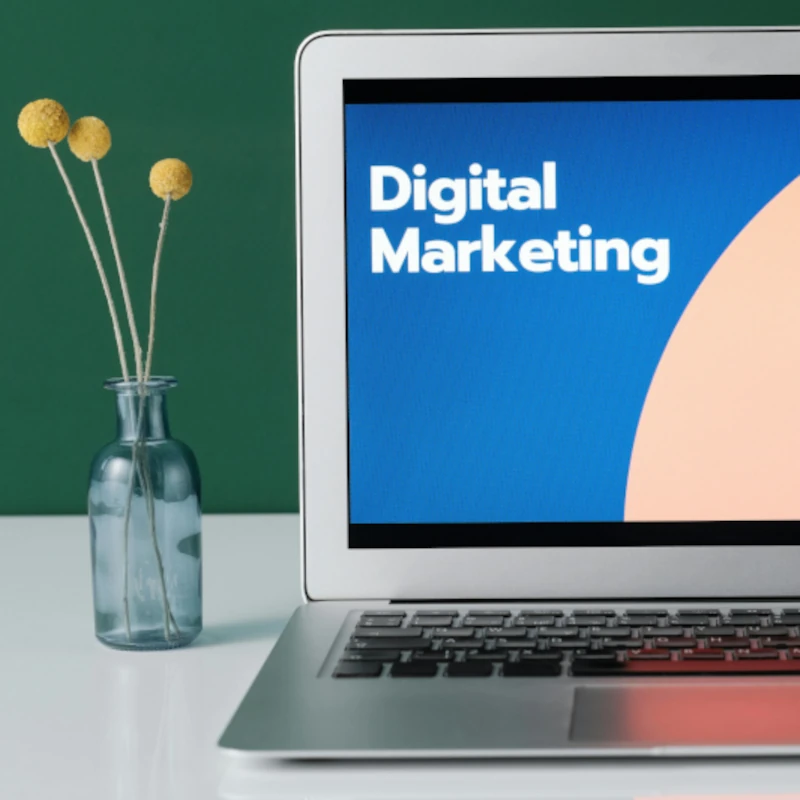Do you want to get your sales to a crazy level? And want to know how to drive sales with a well-designed digital marketing plan? Now, in the advanced times, just having a few social media posts and random ads isn’t enough. First of all, you need a step-by-step digital marketing plan that drives sales in a real sense.
This blog will show you exactly how to build one. It will teach you how to develop an effective sales-focused digital marketing strategy that suits your brand, whether it involves setting smart goals, selecting the right marketing channels, measuring performance, etc.
What Is a Digital Marketing Plan?

Let’s start simple.
A digital marketing plan is a strategic roadmap that provides a plan of how your business will leverage digital channels, such as social media, search engines, email and content, to meet sales and growth objectives.
It’s not a list of tasks. It’s a strategy that has an objective, target, message and approach.
And more importantly, it connects directly to your bottom line… “sales”.
Why You Need One:
- It helps you focus on what really works
- Saves time and budget by avoiding scattered efforts
- Gives your team direction and clear priorities
- Makes it easier to measure accurate results
The Interaction of Strategy, Campaigns and Tactics
Strategy has been confused by many with campaigns and tactics. Let’s just quickly break that down through a table:
| Term | What It Means | Example |
|---|---|---|
| Strategy | Big-picture plan to reach long-term goals | “Grow online sales by 30% in 12 months.” |
| Campaigns | Time-limited efforts supporting the strategy | “Holiday email campaign with 15% off.” |
| Tactics | Specific tasks to run the campaign | “Design landing page, write promo email.” |
10 Steps to Build a Digital Marketing Plan That Drives Sales

1. Make SMART goals
Start thinking of the end first.
You should have a goal of being SMART: Specific, Measurable, Achievable, Relevant and Time-bound.
Example: 25% product sales growth online within 6 months.
These goals keep you on track and monitor your progress.
2. Know your audience
There is no way that one can sell without knowing the people that they are selling to.
Create buyer personas, which are fictional characters, and are based on your actual customers. Use tools such as Google Analytics, surveys or customer interviews to identify:
- Their age, places of residence and occupation
- Challenges and pain points
- Where do they spend time online
This assists you in developing focused content that is in their language.
3. Audit Your Digital Presence Now
Take a look at what you already have before you go ahead.
- Website performance: Is it Mobile-friendly? Fast? SEO friendly?
- Content: What is already working in terms of blogs, videos or resources?
- Social media: Which platforms get the biggest engagement?
- Email marketing: Do you have clicks and conversions?
Prepare a list of strengths and gaps in order to know what to retain and what to make better.
Pro tip:
Have a quick SWOT (Strengths, Weaknesses, Opportunities, Threats) analysis.
It helps you know what you’re doing right, where you’re coming up short and where you can improve, giving your plan more clarity. For example, an audit supported by the Best SEO Agency Nottingham can provide deeper insights into your local search visibility.
4. Choose the right digital channel
You don’t have to be everywhere but rather where your audience is.
The important channels to look at include:
- SEO: Best for long term organic traffic
- Social Media: Facebook, Instagram, LinkedIn- it all depends on your audience
- Email Marketing: Keep leads & customers
- PPC (Pay-per-click): When you need instant traffic, most especially during promo.
- Content Marketing: Blog Posts, Videos & guides to build trust
- Influencer Marketing: Reach into niche audiences
Select 2 or 3 core channels and do them well rather than spreading thin.
5. Write Messages That Sell
This is where psychology and creativity intersect.
Your message should:
- Address a pain point
- Provide an answer (your product/service)
- Make it urgent (why now?)
- Be contextual to the stage that the customer is in (awareness, consideration, decision)
Pairing a strong message with services like SEO Services Portsmouth can help it reach the right local audience faster.
6. Create a Content Plan That Supports Sales
Don’t post just for likes. Post for conversions.
Plan content around the sales funnel:
- Top of Funnel (Awareness): Blog posts, Infographics etc.
- Middle of funnel (interest): Case studies, webinars
- Bottom of the funnel (decision): References, product demos, limited-time offers
Plan what content goes where, when and on which channel.
7. Allocate Budget & Resources
Even a small budget can go far if you plan smart.
Think about:
- Ad spend (e.g. Facebook or Google Adwords)
- Tools (e.g. email software or design apps)
- Content creation (in-house or out-sourced?)
- Influencer or paid partnerships
Hint: Save a portion of your budget to experiment on new channels and formats.
8. Use Marketing Automation Tools
To really drive sales consistently, use tools to automate tasks:
- Email sequences
- Abandoned cart messages
- Lead scoring and nurturing
- A/B testing
The use of such tools as HubSpot, Mailchimp or even Brevo (Sendinblue) will help you to remain efficient and consistent.
9. Track KPIs (Key Performance Indicators)
What is not measured, is not improved.
Some sales-driven KPIs:
- Conversion rate ( visitor to lead or buyer )
- Cost per acquisition (CPA)
- Return on advertising (ROAS)
- Customer lifetime value (CLTV)
- Click through rate (CTR)
Plan reporting schedule, e.g. weekly or monthly and keep track of the results using such tools as Google Analytics, HubSpot or Looker Studio.
10. Optimize and Adjust on a Regular Basis
Digital marketing is not a set and forget game.
Review your plan every 30–60 days. Ask:
- What’s working? Do more of that.
- What’s underperforming? Change or pause it.
- What new trends or tools can we try?
Continuous tweaking is how a digital marketing plan becomes a sales machine.
That is how a digital marketing strategy turns into a sales machine through continuous tweaking.
Real Life Example: Sales Through Smart Strategy
Suppose you are selling an online course.
You:
- Make a landing page and add a countdown and testimonials
- Place on Facebook an advertisement to young professionals
- Put a 3-email sequence on those who download your free PDF
- Monitor the conversions using Google Analytics
You know not to guess as you take each step, which is included in your plan and you are leading your audience to purchase.
Final Thoughts: A Good Plan = Better Sales
Digital marketing plan that generates sales does not have to be overwhelming. It only requires optimization, planning and consistency.
Begin with making clear objectives, research about your audience, identify the best channels and remain open-minded to testing and learning. You are a small business or an enterprise, this approach will provide you with a roadmap to real results not just vanity metrics. For long-term lead generation, considering SEO Services Sheffield can help boost your organic reach across the funnel.
Faqs
How to make sales with digital marketing?
Mix brand awareness, lead generation, customer journey optimization and the right digital channels to drive sales with digital marketing.
What is a beginner-friendly digital marketing plan?
It’s just as easy to start with as a beginner and it includes understanding your audience, sharing something useful and concentrating on 1-2 channels and tracking the outcome.
Does digital marketing work for driving sales?
Yes, if it’s done right. It brings the genuine people to you and turns them into paying customers.


